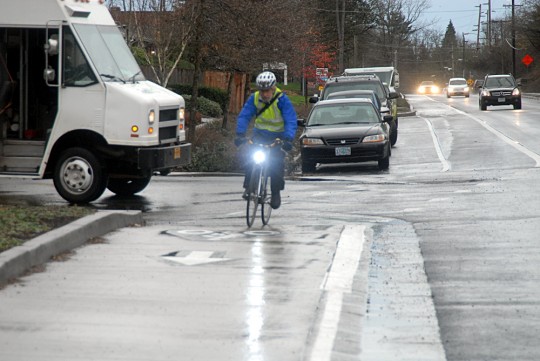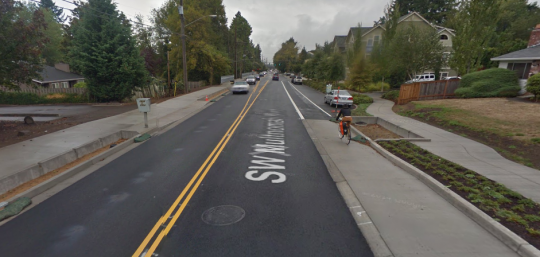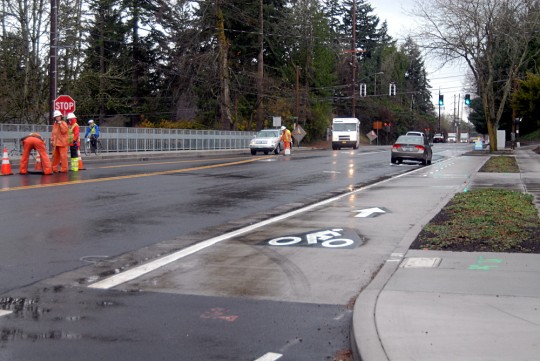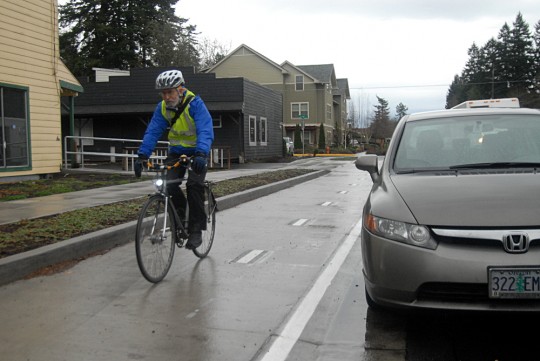Like NE Cully Boulevard before it, SW Multnomah Boulevard has become a relatively far-flung street with a few blocks of one of the city’s best bike lanes.
With work nearly finished on the city’s eighth protected bike lane — three years in the making, it’s one of the last few bike projects begun under the Sam Adams mayoral administration — I stopped by Multnomah Tuesday to check it out.
Here’s the stretch of road that has been rebuilt, which covers about one-third of the mile or so that connects Multnomah Village to Barbur Boulevard:
Here’s a 2007 Google Street View shot from near the east end of the project:
And here’s one from this September, when construction was nearing completion:
As you see, the project also greatly improved the sidewalk here and added some natural stormwater drainage areas to each side of the street.
Many Portlanders will remember the media fury that erupted in 2010 when Mayor Adams ordered storm runoff projects that were going to lead to street rebuilding to coordinate with the transportation bureau so they could also include upgrades to bike facilities. Behold one of the few results.
According to project manager Rich Newlands, this project cost $4 million, half of it from stormwater improvement money (which comes from Portlanders’ water/sewer bills) and half from the state’s 2009 gas tax hike.
The north side of the street, where traffic points from Barbur toward Capitol Highway and Multnomah Village, has a 6.5-foot-wide curb-raised bike lane for a few blocks, which curves to the right behind a few car parking spaces.
The relatively low demand for street parking here means that there isn’t always another car to show how it works – but the markings are newly installed so more people will probably figure it out. Assuming people do park their cars in the right place, there are some advisory markings to help remind you to avoid the right-door zone. (Without markings like these, bike lanes are demonstrably terrible at keeping people out of door zones.)
Another advantage of this setup is that the right door of a car opens much less often than the left one.
Advertisement
As for the curb itself, it’s got a very smooth grade and is easy to move on and off, much like the ones Jonathan saw last year in Copenhagen. (With all the Danophiles in the Portland Bureau of Transportation, I’m sure this is no coincidence.)
And here’s one nice touch at the western end of the project: a bike signal detector to help stop you from being stranded at a red light. It looks as if it’ll soon get a stencil to help indicate where you should pedal to activate the light.
On the south side of the street, which leads traffic eastbound toward Barbur (and downtown Portland) the design is different. It’s a 9-foot wide pathway designed to be shared by people walking and biking:
Portland Bicycle Planning Coordinator Roger Geller said this should be considered a “shared pathway” rather than a “sidewalk” because of two factors: “width and intent.”
In addition to having room for a bike to pass someone walking (though not two people walking side by side), this path has ramps on both ends that make it easy and intuitive to bike on and off of.
In the second photo, you can also see the newest installment of Portland’s new favorite tool: the rapid-flash beacon, which gives people the option of drawing attention to the fact that they’re about to use a crosswalk.
Geller said he thinks this merging of bike and foot traffic will work because the south side of Multnomah doesn’t have much development.
“We don’t see that as being a very high-demand walking corridor there,” he said. “Those properties are not likely to turn over and redevelop any time soon, if ever. Certainly not in any significant way.”
Earlier plans had actually called for no sidewalk at all, but that idea was scotched.
“We recognized that if we put some concrete out there, people were going to walk on it,” Geller said.
In about half an hour, I only saw one man biking here midmorning on a rainy Tuesday. But talked to one woman, walking her dog on the new sidewalk, who said this project has let her son bike to school when she wouldn’t have let him use the street before. She expressed hope that it’ll eventually be extended further west.
This project, though it’s very nice to ride, won’t make a huge difference to the area until more of Multnomah is rearranged — three blocks of riding outside a door zone aren’t much good if you’re back in the door zone for the next three.
But the real payoff here is very long-term: if Southwest Barbur is chosen as the route for the planned Southwest Corridor project, as most people expect it to be, there’ll be a chance for the street to get comfortable bike lanes leading to many important commercial nodes and, thrillingly, a relatively flat all-ages bike connection to the rest of the city.
If Portland can make that happen, this link between Barbur and one of Southwest Portland’s coolest commercial areas (Multnomah Village) will be essential. Kudos to the city for having the foresight to snatch this opportunity when it came up.










